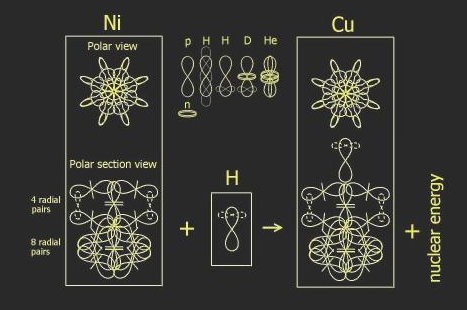Remarkable advances in cold fusion research have raised the hope for a safer and cheaper nuclear energy. The results, however, cannot be explained from the point of view of current physical understanding of nuclear fusion. This is an obstacle to endorsement and investment in this field. The research needs a supporting theory. My book “Structural Physics of Nuclear Fusion” offers a new approach for analysis and practical recommendations based on the physical models of atomic nuclei derived in the BSM-Supergravitation Unified theory (BSM-SG). The book provides: (1) a method for analysis of the low-energy nuclear reactions (LENR) experiments using the BSM-SG atomic models; (b) a selection of isotopes for efficient energy yield with a minimum of radioactive byproducts; (c) practical considerations for selection of the technical method and the reaction environment.
The BSM-SG theory is based on a concept of space that follows the view of Michael Faraday and the recommendations of James Maxwell about the properties of the space, known as Aether. The concept of an Aether (Ether) was abandoned in favor of the quantum mechanical formalism adopted in the first quarter of 20th century. However, Albert Einstein openly expressed his concern after he developed General Relativity. In his monograph “Sidelights on relativity” (1921) he wrote: “To deny the ether is ultimately to assume that empty space has no physical qualities whatever” (p.23), and “According to general theory of relativity space without ether is unthinkable” (p. 23).
From our point of view, the major problem for understanding the cold fusion, known also as LENR, is the adopted quantum mechanical formalism. In quantum mechanics and particles physics, all elementary and subelementary particles are assumed spherical without any geometrical structure. Then the data interpretation of scattering experiments leads to a very small atomic nucleus on the order of a femtometer. This leads to a conclusion of a very strong Coulomb barrier of the nucleus that might be overcome only at temperatures of millions of degrees. The results from LENR experiments are in sharp contrast to this consideration. According to BSM-SG theory, the physical models of protons and neutrons have superdense material structures with the shape of a folded and a twisted torus, respectively. They are much larger but thinner, so the Coulomb barrier also has a non-spherical shape and it is not so strong. The protons and neutrons are held in the nucleus by a Supergravitational (SG) field, which is behind the strong nuclear forces. The protons and neutrons in the atomic nuclei form three-dimensional fractal structures with spatial geometry defining the row-column pattern of the Periodic table. The structure of each atomic nucleus possesses identifiable feature of the valences, isotope stability, nuclear spin and chemical bond directions. The analysis leads to a hypothesis that the superdense nucleus causes a space micro-curvature—a general relativistic effect around the nucleus. It has a feature of energy storage that corresponds to the mass deficit or nuclear binding energy expressed by the Einstein’s equation “E = mc2”. The fusion or fission reaction causes a small change of the micro-curvature, so the difference in the binding energy is released as gamma and particle radiation that is finally converted to heat—a nuclear energy.
The analysis of some LENR experiments shows that the excited state of hydrogen and deuterium, known as the Rydberg state, facilitates some fusion reactions. According to BSM-SG, the Rydberg state is an ion-electron pair, with a finite size and boundary defined by the SG field, while possessing a strong magnetic field due to the dominated magnetic moment of the electron. Additionally, the anomalous magnetic moment of the electron provides a constant driving momentum. When combined with a proper nuclear spin state of a selected heavier element, this momentum assists the magnetic field interactions, and this leads to nuclear fusion.
See also the published scientific paper, “Physics of Cold Fusion With the BSM–SG Atomic Models”, by the author, and watch his talk at the International Scientific Conference in 2012 preceding the publishing of the book:









The idea of a nucleus being a folded or twisted torus reminds me of the work of Nasim Harramein, who proposes that nuclei are, in effect, torus shaped mini black holes. He also acknowledges that substantial properties of “empty” space, not referring to Aether, but to the stupendous energy density of the vacuum.
The elaborate concept of twisted and folded torus was published in http://lanl.arxiv.org/abs/physics/0205052 (2002) and in http://www.nlc-bnc.ca/amicus/index-e.html (2002) preceding the work of Nassim Haramein by years.
I have no problem with an ether.
There is some other dude who is proposing what he calls the key-ring atom. You might check him out.
I love that some theorists are jumping on LENR and are sitting around denying it.
I believe you are referring to “Quantum Ring Theory”
by Wladimir Guglinski… I wonder how they compare?
That someone has eventually recognized that the worlds leading Physicists have been ‘navel gazing’ since the 1920’s is a miracle. That Matter IS Energy and not ‘particles’ should have been foremost in their reasoning. Further to this, to assume that these energy packets only exist at at point beggars belief. The twin slit experiment conclusively proves that Electrons occupy volume and are not ‘bullets’ as described by Feynman. Electrons produce interference patterns by interference with their own field extremities.
Now try getting Hawking to reply to your letters!
What do you think of the Widom-Larsen theory? It explains LENR by neutron capture which avoids the need to overcome the coulomb barrier.
What a bunch of nonsense! WHERE do they find these people? The W-L “theory” is also a crock; “avoiding the need to overcome the Coulomb barrier” by postulating mystical neutrons simply causes more problems. For example, most neutrons undergo elastic or inelastic scatter with heavy nuclei, not capture, and interaction cross sections are minuscule (measured in barns; 1E-24 cm2). Thus there should be copious neutrons that could be detected, but there are none.